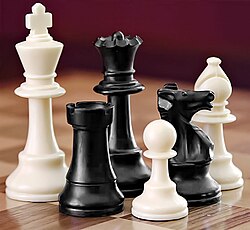
Back قوانين الشطرنج Arabic Правілы шахмат Byelorussian Reglament dels escacs Catalan یاساکانی شەتڕەنج CKB Pravidla šachů Czech Κανόνες του σκακιού Greek Bazaj reguloj de ŝako Esperanto Leyes del ajedrez Spanish Règles du jeu d'échecs French शतरंज के नियम Hindi

The rules of chess (also known as the laws of chess) govern the play of the game of chess. Chess is a two-player abstract strategy board game. Each player controls sixteen pieces of six types on a chessboard. Each type of piece moves in a distinct way. The object of the game is to checkmate the opponent's king; checkmate occurs when a king is threatened with capture and has no escape. A game can end in various ways besides checkmate: a player can resign, and there are several ways a game can end in a draw.
While the exact origins of chess are unclear, modern rules first took form during the Middle Ages. The rules continued to be slightly modified until the early 19th century, when they reached essentially their current form. The rules also varied somewhat from region to region. Today, the standard rules are set by FIDE (Fédération Internationale des Échecs), the international governing body for chess. Slight modifications are made by some national organizations for their own purposes. There are variations of the rules for fast chess, correspondence chess, online chess, and Chess960.
Besides the basic moves of the pieces, rules also govern the equipment used, time control, conduct and ethics of players, accommodations for physically challenged players, and recording of moves using chess notation. Procedures for resolving irregularities that can occur during a game are provided as well.